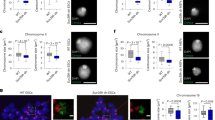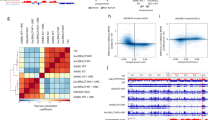Abstract
While reversible histone modifications are linked to an ever-expanding range of biological functions1,2,3,4,5, the demethylases for histone H4 lysine 20 and their potential regulatory roles remain unknown. Here we report that the PHD and Jumonji C (JmjC) domain-containing protein, PHF8, while using multiple substrates, including H3K9me1/2 and H3K27me2, also functions as an H4K20me1 demethylase. PHF8 is recruited to promoters by its PHD domain based on interaction with H3K4me2/3 and controls G1–S transition in conjunction with E2F1, HCF-1 (also known as HCFC1) and SET1A (also known as SETD1A), at least in part, by removing the repressive H4K20me1 mark from a subset of E2F1-regulated gene promoters. Phosphorylation-dependent PHF8 dismissal from chromatin in prophase is apparently required for the accumulation of H4K20me1 during early mitosis, which might represent a component of the condensin II loading process. Accordingly, the HEAT repeat clusters in two non-structural maintenance of chromosomes (SMC) condensin II subunits, N-CAPD3 and N-CAPG2 (also known as NCAPD3 and NCAPG2, respectively), are capable of recognizing H4K20me1, and ChIP-Seq analysis demonstrates a significant overlap of condensin II and H4K20me1 sites in mitotic HeLa cells. Thus, the identification and characterization of an H4K20me1 demethylase, PHF8, has revealed an intimate link between this enzyme and two distinct events in cell cycle progression.
This is a preview of subscription content, access via your institution
Access options
Subscribe to this journal
Receive 51 print issues and online access
$199.00 per year
only $3.90 per issue
Buy this article
- Purchase on Springer Link
- Instant access to full article PDF
Prices may be subject to local taxes which are calculated during checkout




Similar content being viewed by others
References
Kouzarides, T. Histone methylation in transcriptional control. Curr. Opin. Genet. Dev. 12, 198–209 (2002)
Bhaumik, S. R., Smith, E. & Shilatifard, A. Covalent modifications of histones during development and disease pathogenesis. Nature Struct. Mol. Biol. 14, 1008–1016 (2007)
Lachner, M., O’Sullivan, R. J. & Jenuwein, T. An epigenetic road map for histone lysine methylation. J. Cell Sci. 116, 2117–2124 (2003)
Ruthenburg, A. J., Li, H., Patel, D. J. & Allis, C. D. Multivalent engagement of chromatin modifications by linked binding modules. Nature Rev. Mol. Cell Biol. 8, 983–994 (2007)
Klose, R. J., Kallin, E. M. & Zhang, Y. JmjC-domain-containing proteins and histone demethylation. Nature Rev. Genet. 7, 715–727 (2006)
Heintzman, N. D. et al. Histone modifications at human enhancers reflect global cell-type-specific gene expression. Nature 459, 108–112 (2009)
Mellor, J. It takes a PHD to read the histone code. Cell 126, 22–24 (2006)
Loenarz, C. et al. PHF8, a gene associated with cleft lip/palate and mental retardation, encodes for an Nε-dimethyl lysine demethylase. Hum. Mol. Genet. 19, 217–222 (2010)
Fortschegger, K. et al. PHF8 targets histone methylation and RNA polymerase II to activate transcription. Mol. Cell Biol. advance online publication, 10.1128/MCB.01520-09 (26 April 2010)
Horton, J. R. et al. Enzymatic and structural insights for substrate specificity of a family of jumonji histone lysine demethylases. Nature Struct. Mol. Biol. 17, 38–43 (2010)
Kleine-Kohlbrecher, D. et al. A functional link between the histone demethylase PHF8 and the transcription factor ZNF711 in X-linked mental retardation. Mol. Cell 38, 165–178 (2010)
Feng, W., Yonezawa, M., Ye, J., Jenuwein, T. & Grummt, I. PHF8 activates transcription of rRNA genes through H3K4me3 binding and H3K9me1/2 demethylation. Nature Struct. Mol. Biol. 17, 445–450 (2010)
Jørgensen, S. et al. The histone methyltransferase SET8 is required for S-phase progression. J. Cell Biol. 179, 1337–1345 (2007)
Tardat, M., Murr, R., Herceg, Z., Sardet, C. & Julien, E. PR-Set7-dependent lysine methylation ensures genome replication and stability through S phase. J. Cell Biol. 179, 1413–1426 (2007)
Houston, S. I. et al. Catalytic function of the PR-Set7 histone H4 lysine 20 monomethyltransferase is essential for mitotic entry and genomic stability. J. Biol. Chem. 283, 19478–19488 (2008)
Yin, Y., Yu, V. C., Zhu, G. & Chang, D. C. SET8 plays a role in controlling G1/S transition by blocking lysine acetylation in histone through binding to H4 N-terminal tail. Cell Cycle 7, 1423–1432 (2008)
Oda, H. et al. Monomethylation of histone H4-lysine 20 is involved in chromosome structure and stability and is essential for mouse development. Mol. Cell. Biol. 29, 2278–2295 (2009)
Tyagi, S., Chabes, A. L., Wysocka, J. & Herr, W. E2F activation of S phase promoters via association with HCF-1 and the MLL family of histone H3K4 methyltransferases. Mol. Cell 27, 107–119 (2007)
Wysocka, J., Myers, M. P., Laherty, C. D., Eisenman, R. N. & Herr, W. Human Sin3 deacetylase and trithorax-related Set1/Ash2 histone H3–K4 methyltransferase are tethered together selectively by the cell-proliferation factor HCF-1. Genes Dev. 17, 896–911 (2003)
Trojer, P. et al. L3MBTL1, a histone-methylation-dependent chromatin lock. Cell 129, 915–928 (2007)
Julien, E. & Herr, W. Proteolytic processing is necessary to separate and ensure proper cell growth and cytokinesis functions of HCF-1. EMBO J. 22, 2360–2369 (2003)
Losada, A. & Hirano, T. Dynamic molecular linkers of the genome: the first decade of SMC proteins. Genes Dev. 19, 1269–1287 (2005)
Hudson, D. F., Marshall, K. M. & Earnshaw, W. C. Condensin: architect of mitotic chromosomes. Chromosome Res. 17, 131–144 (2009)
Belmont, A. S. Mitotic chromosome structure and condensation. Curr. Opin. Cell Biol. 18, 632–638 (2006)
Haering, C. H. Foreword: the many fascinating functions of SMC protein complexes. Chromosome Res. 17, 127–129 (2009)
Wolf, F., Sigl, R. & Geley, S. '… The end of the beginning': cdk1 thresholds and exit from mitosis. Cell Cycle 6, 1408–1411 (2007)
Ono, T. et al. Differential contributions of condensin I and condensin II to mitotic chromosome architecture in vertebrate cells. Cell 115, 109–121 (2003)
Strahl, B. D. & Allis, C. D. The language of covalent histone modifications. Nature 403, 41–45 (2000)
Neuwald, A. F. & Hirano, T. HEAT repeats associated with condensins, cohesins, and other complexes involved in chromosome-related functions. Genome Res. 10, 1445–1452 (2000)
Andrade, M. A. & Bork, P. HEAT repeats in the Huntington’s disease protein. Nature Genet. 11, 115–116 (1995)
Garcia-Bassets, I. et al. Histone methylation-dependent mechanisms impose ligand dependency for gene activation by nuclear receptors. Cell 128, 505–518 (2007)
Langmead, B., Trapnell, C., Pop, M. & Salzberg, S. L. Ultrafast and memory efficient alignment of short DNA sequences to the human genome. Genome Biol. 10, R25 (2009)
Zhang, Y. et al. Model-based analysis of ChIP-Seq (MACS). Genome Biol. 9, R137 (2008)
Zang, C. et al. A clustering approach for identification of enriched domains from histone modification ChIP-Seq data. Bioinformatics 25, 1952–1958 (2009)
Huang D. W, Sherman, B. T. & Lempicki, R. A. Systematic and integrative analysis of large gene lists using DAVID bioinformatics resources. Nature Protocols 4, 44–57 (2009)
Maere, S., Heymans, K. & Kuiper, M. BiNGO: a Cytoscape plugin to assess overrepresentation of gene ontology categories in biological networks. Bioinformatics 21, 3448–3449 (2005)
Šášik, R., Woelk, C. H. & Corbeil, J. Microarray truths and consequences. J. Mol. Endocrinol. 33, 1–9 (2004)
Tusher, V. G., Tibshirani, R. & Chu, G. Significance analysis of microarrays applied to the ionizing radiation response. Proc. Natl Acad. Sci. USA 98, 5116–5121 (2001)
Saeed, A. I. et al. TM4 microarray software suite. Methods Enzymol. 411, 134–193 (2006)
Schwender, H. & Ickstadt, K. Empirical Bayes analysis of single nucleotide polymorphisms. BMC Bioinformatics 9, 144 (2008)
Tanner, S. et al. InsPecT: identification of posttranslationally modified peptides from tandem mass spectra. Anal. Chem. 77, 4626–4639 (2005)
Yeong, F. M. et al. Identification of a subunit of a novel Kleisin-β/SMC complex as a potential substrate of protein phosphatase 2A. Curr. Biol. 13, 2058–2064 (2003)
Acknowledgements
We thank W. Herr for providing HCF-1 and SET1A antibody; A. C. Wilson for providing pCGN-GAL4-HA-HCF-1(N1011) and pCGN-GAL4-HA-HCF-1(C600) expression vectors; A. I. Lamond for providing YFP-HCF-1 expression vector; K. Wang for experimental assistance; J. Nand for assistance with the ChIP-Seq data analysis; C. Nelson for cell culture assistance; J. Hightower and D. Benson for assistance with figure and manuscript preparation and the UCSD BIOGEM laboratory for RNA profiling. M.G.R. is an Investigator with the Howard Hughes Medical Institute. This work was supported by grants from NIH and NCI to A.K.A., P.C.D., C.K.G, A.D. and M.G.R. and from DOD and PCF to M.G.R. We apologize that we were not able to cite all the studies in the primary references characterizing PHF8 family enzymatic activities while our work was under review, due to reference limitation.
Author information
Authors and Affiliations
Contributions
W.L. and M.G.R. designed the experiments and W.L. performed most of the experiments. W.L. and M.G.R. prepared the manuscript with contributions of I.G.-B., A.K.A., A.D., P.C.D. and C.K.G.; B.T. and C.B. analysed the ChIP-Seq and microarray data. T.Y.Z and K.A.O generated Flag–PHF8 constructs. W.T.L. helped with mass spectrometry analysis. R.G. and O.V.T. performed confocal microscopy in mitosis. I.G.-B performed gel filtration chromatograph.
Corresponding author
Ethics declarations
Competing interests
The authors declare no competing financial interests.
Supplementary information
Supplementary Figures
This file contains Supplementary Figures S1-S18 with legends. (PDF 4649 kb)
Rights and permissions
About this article
Cite this article
Liu, W., Tanasa, B., Tyurina, O. et al. PHF8 mediates histone H4 lysine 20 demethylation events involved in cell cycle progression. Nature 466, 508–512 (2010). https://doi.org/10.1038/nature09272
Received:
Accepted:
Published:
Issue Date:
DOI: https://doi.org/10.1038/nature09272
This article is cited by
-
H4-methylation regulators mediated epitranscriptome patterns and tumor microenvironment infiltration characterization in hepatocellular carcinoma
Clinical Epigenetics (2023)
-
Epigenetic instability caused by absence of CIZ1 drives transformation during quiescence cycles
BMC Biology (2023)
-
Loss of PHF8 induces a viral mimicry response by activating endogenous retrotransposons
Nature Communications (2023)
-
Aggressive variants of prostate cancer: underlying mechanisms of neuroendocrine transdifferentiation
Journal of Experimental & Clinical Cancer Research (2022)
-
Roles for the methyltransferase SETD8 in DNA damage repair
Clinical Epigenetics (2022)
Comments
By submitting a comment you agree to abide by our Terms and Community Guidelines. If you find something abusive or that does not comply with our terms or guidelines please flag it as inappropriate.



